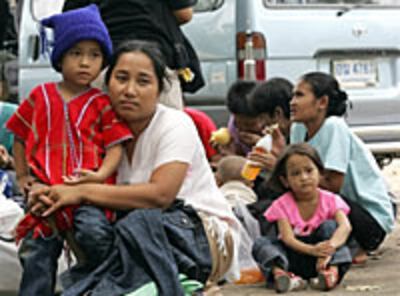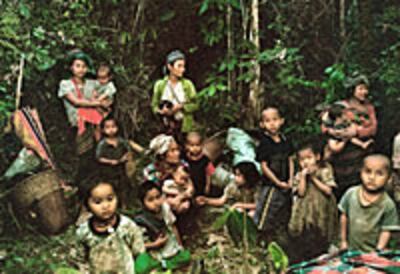
BANGKOK—Burmese army attacks in the eastern Karen ethnic region have displaced thousands, driving some to camps near the Thai border and leaving others hiding in the jungle without adequate food, aid workers and Karen people have told RFA’s Burmese service.
Speaking by satellite phone with RFA’s Burmese service, a Karen villager now in hiding said, “They destroy our farms, eat our rice, shoot us, and kill us.”
Pho Chitho, driven from his farm by army attacks, said he is now living in the jungle with his five children and about 5,000 others from his village and neighboring villages in the Mone township of Nyaunglebin District.
'Grave concern'
“Winter has started, and it is very cold,” he said. “The health of both children and adults is deteriorating. The rain is very heavy, and we have to live in makeshift tents. But we can’t stay in one place. We have to move about four times a day.”
New York-based Human Rights Watch on Nov. 30 warned of its “grave concern for the food security of the local population,” citing concerns that the army—now fighting a year-long offensive against Karen resistance fighters—may try to seize food stocks for itself.
Winter has started, and it is very cold. The health of both children and adults is deteriorating. The rain is very heavy, and we have to live in makeshift tents. But we can’t stay in one place. We have to move about four times a day.
“The army has previously taken measures to disrupt the harvest, including laying thousands of landmines around houses and fields to deter civilians from approaching their villages and crops,” Human Rights Watch said.
The Burmese army pursues and attacks even at night, Pho Chitho said. “We can’t go to take care of our farms because they plant landmines on the farms. They plant mines everywhere, in the farms, in the villages, on the pathways. Everywhere.”
Five people in his group were recently injured in landmine blasts, Pho Chitho said. Two were killed. “Now we are in the deep jungle and are calling you from our hiding. Please let the world know our situation. Please help us.”

Estimates of the numbers of Karen villagers displaced in the fighting vary, with Human Rights Watch estimating a total of 27,000 forced from their homes during the last year.
“More than 500,000 civilians are [already] living as internally displaced people along the eastern Burma border with Thailand,” Human Rights Watch said. “But this figure likely underestimates the true numbers, since some areas are too dangerous to survey.”
The Thailand-based Back Pack Health Worker Teams (BPHWT), an aid group active in Burma’s Karen region, told RFA that over 10,000 civilians have been displaced in the most recent fighting alone.
More than 500,000 civilians are [already] living as internally displaced people along the eastern Burma border with Thailand...But this figure likely underestimates the true numbers, since some areas are too dangerous to survey.
“Some villagers are still hidden in the jungle, near their homeland,” said BPHWT spokesman Mahn Mahn. “Those people are provided with health care by Back Pack Health Worker Teams and other groups.”
In an interview, a Karen villager who asked not to be named said landmines placed throughout the region are a constant threat.
Landmines in the countryside
In January 2006, he said, two villagers from Taungu Township stepped on mines while returning from their farms. One lost a leg. The other lost a leg below the knee. The men were taken to Taungu Hospital, where they were interviewed by a representative of the International Committee of the Red Cross (ICRC).
“[The] ICRC came and helped with the hospital costs and costs for medicine and travel to the hospital. When the local ICRC representative interviewed the victims, they told him that the mines had been placed close to their village by government troops.”
The next day, Burmese military intelligence officials came to the hospital and told the injured men to tell the ICRC that the mines had been placed by members of the Karen National Union (KNU), a rebel group. They were also instructed to tell others that their medical help had been provided not by the ICRC but by the Burmese government.
“ICRC representatives were then barred from coming to the hospital,” RFA’s source said.
On Oct. 23, the Burmese government ordered five ICRC field offices to close. Then, in a press conference, the government said the offices had been only temporarily suspended, pending government introduction of new “rules and regulations” governing ICRC operations in the country.
Thierry Ribaux, ICRC representative in Burma’s capital, Rangoon, criticized the closure and pointed to his organization’s long record of work in Burma to help victims of landmine blasts.
“The ICRC began its program for the physical rehabilitation of amputees and has supported the work of orthopedics centers throughout the country since 1986 and has never stopped,” Ribaux said.
“The field offices play a very important role because they help to direct amputees to the various orthopedics centers. So if these offices are closed, these activities will have to be scaled down.”
Original reporting by Khin May Zaw of RFA’s Burmese service. Written in English with additional reporting by Richard Finney. Edited for the Web by Sarah Jackson-Han.
